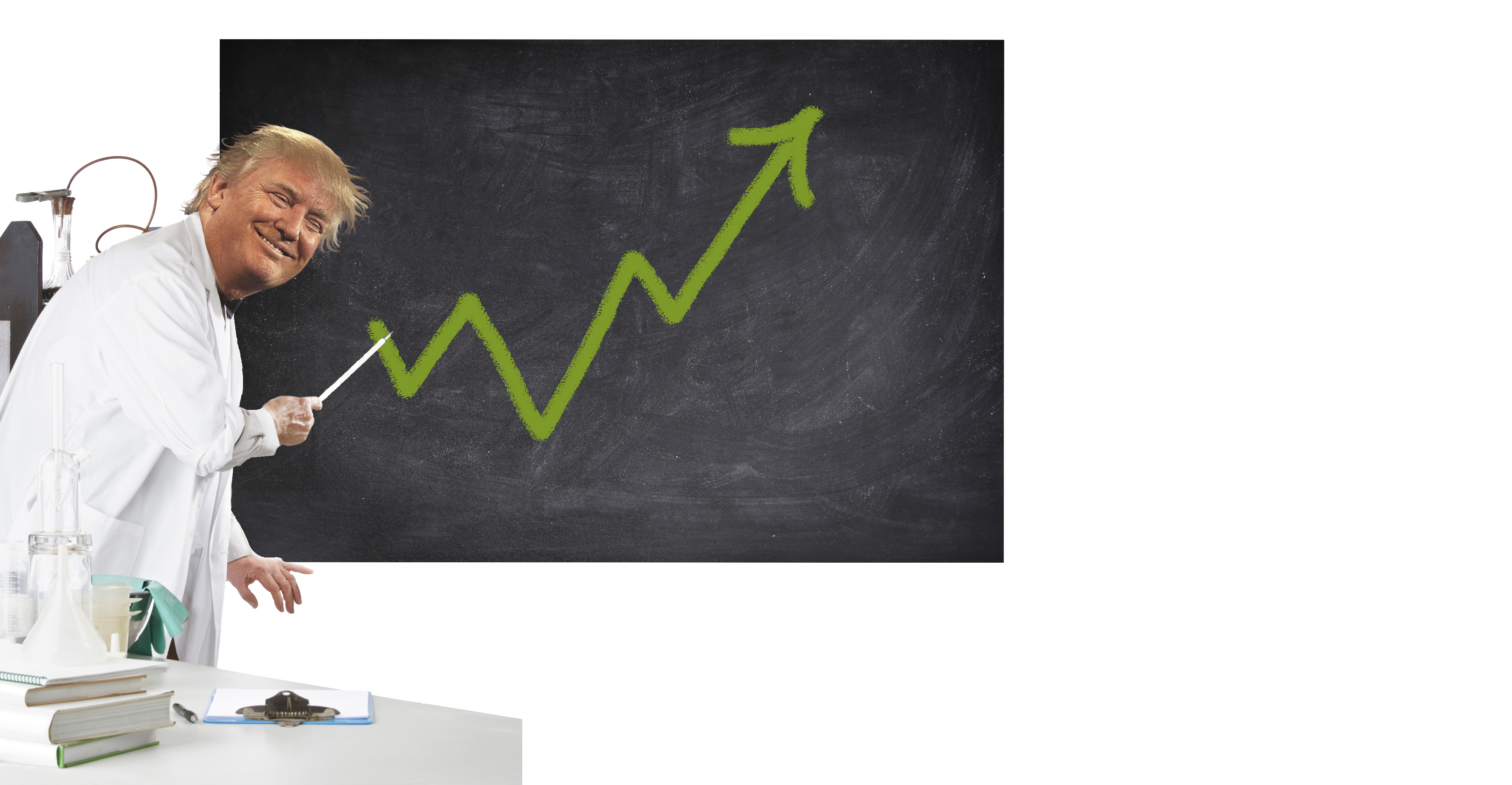America's economy is booming. Trump has nothing to do with it.
The crowing from the MAGA crowd is all sound and fury


Get ready for a lot of terrible Republican punditry.
On Friday morning, the U.S. Commerce Department will give its advanced estimate of how fast the national economy grew from April through June. And that second-quarter GDP report will probably show it grew pretty darn fast. Plenty of Wall Street economists are looking for an annualized growth rate of around 4 percent — maybe even 5 percent — vs. 2 percent in the first quarter and 2.3 percent for all of last year.
The GOP hot takes will come as fast and furious as the economic growth. "The tax cuts worked!" "Trumponomics rocks!" Expect to see #MAGA trending across social media, along with plenty of conservative snark about the failings of the "Obama economy." It might be a good time for Democrats to close their apps and start working through that summer reading list.
The Week
Escape your echo chamber. Get the facts behind the news, plus analysis from multiple perspectives.

Sign up for The Week's Free Newsletters
From our morning news briefing to a weekly Good News Newsletter, get the best of The Week delivered directly to your inbox.
From our morning news briefing to a weekly Good News Newsletter, get the best of The Week delivered directly to your inbox.
Celebrating a stronger economy is not a bad thing, of course. Over the long run, sustainable economic growth is what generates higher living standards and greater social mobility. But drawing sweeping conclusions from a single three-month period is problematic — even if politically tempting.
For one thing, it doesn't necessarily tell you a whole lot about where the economy is heading. There were eight quarters of 3 percent growth or faster scattered across the Obama presidency, including four of 4 percent or faster and one of 5.2 percent. But there was never much follow-through, and overall the expansion muddled through at roughly a 2 percent annual pace. This GDP report will probably tell us even less than usual. RSM economist Joseph Brusuelas is looking for robust 5.1 percent growth, but thinks almost half of that, 2.3 percent, will be due to an artificial, one-time boost from farm exports as U.S. exporters of agricultural products such as soybeans rushed to beat China's retaliatory tariffs.
Moreover, even a very strong report won't tell us whether the Trump tax cuts, passed in December, are "working." It's just too soon. Over time, cutting the U.S. corporate tax rate to 21 percent from 35 percent should give American companies more incentive to earn more taxable income by buying equipment and expanding factories here at home. More business capital should make workers more productive and therefore more valuable to employers, resulting in higher wages.
But that process will play out over a numbers of years, assuming it isn't mostly canceled out because of higher interest rates from the higher budget deficits caused by the revenue-losing tax cuts. On that front, Trump didn't do himself any favors by recently attacking the Federal Reserve for its tightening of monetary policy. Trump's criticism could backfire by nudging the central bank to raise interest rates more to reaffirm its independence from political meddling.
A free daily email with the biggest news stories of the day – and the best features from TheWeek.com
Of course, Trump's tax cuts surely did spur some growth. The personal income tax cuts should temporarily boost consumer spending and GDP growth for a bit. But that stimulus — what Republicans used to lambaste as "Keynesian, sugar-high economics" — will fade. Indeed, if you look at most Wall Street economic forecasts a couple years out, the only detectable residue from the Trump tax cuts is trillion-dollar budget deficits.
Unfortunately, Republican pols and pundits aren't the only ones afflicted with hot-take fever. Democrats have been playing up research from PayScale, a compensation analytics firm, showing that worker wages, adjusted for inflation, have been falling this year. CBS MoneyWatch seemed to channel the DNC in summing up the study: "Six months after the Tax Cut and Jobs Act became law, there's still little evidence that the average job holder is feeling the benefit." Too soon! And other widely followed wage trackers, such as the Labor Department's Employment Cost Index, suggest real wages have been rising. So just like conservatives, liberals need to pump the brakes before declaring the tax cuts a failure.
Finally, honest critiques of the Obama economy (and the Fed) and the historic weakness of the recovery need to account for some mitigating factors, including that the biggest ongoing drags on growth — weak productivity and labor force growth — both started before Barack Obama took office. Also, recessions accompanied by financial crises, such as the Great Recession, might be more prone to anemic aftermaths, some research suggests.
And if all this context and nuance is too much for Republicans, maybe they should spend Friday doing their summer reading, too.
James Pethokoukis is the DeWitt Wallace Fellow at the American Enterprise Institute where he runs the AEIdeas blog. He has also written for The New York Times, National Review, Commentary, The Weekly Standard, and other places.
-
 7 bars with comforting cocktails and great hospitality
7 bars with comforting cocktails and great hospitalitythe week recommends Winter is a fine time for going out and drinking up
-
 7 recipes that meet you wherever you are during winter
7 recipes that meet you wherever you are during winterthe week recommends Low-key January and decadent holiday eating are all accounted for
-
 Nine best TV shows of the year
Nine best TV shows of the yearThe Week Recommends From Adolescence to Amandaland
-
 Bari Weiss’ ‘60 Minutes’ scandal is about more than one report
Bari Weiss’ ‘60 Minutes’ scandal is about more than one reportIN THE SPOTLIGHT By blocking an approved segment on a controversial prison holding US deportees in El Salvador, the editor-in-chief of CBS News has become the main story
-
 Has Zohran Mamdani shown the Democrats how to win again?
Has Zohran Mamdani shown the Democrats how to win again?Today’s Big Question New York City mayoral election touted as victory for left-wing populists but moderate centrist wins elsewhere present more complex path for Democratic Party
-
 Millions turn out for anti-Trump ‘No Kings’ rallies
Millions turn out for anti-Trump ‘No Kings’ ralliesSpeed Read An estimated 7 million people participated, 2 million more than at the first ‘No Kings’ protest in June
-
 Ghislaine Maxwell: angling for a Trump pardon
Ghislaine Maxwell: angling for a Trump pardonTalking Point Convicted sex trafficker's testimony could shed new light on president's links to Jeffrey Epstein
-
 The last words and final moments of 40 presidents
The last words and final moments of 40 presidentsThe Explainer Some are eloquent quotes worthy of the holders of the highest office in the nation, and others... aren't
-
 The JFK files: the truth at last?
The JFK files: the truth at last?In The Spotlight More than 64,000 previously classified documents relating the 1963 assassination of John F. Kennedy have been released by the Trump administration
-
 'Seriously, not literally': how should the world take Donald Trump?
'Seriously, not literally': how should the world take Donald Trump?Today's big question White House rhetoric and reality look likely to become increasingly blurred
-
 Will Trump's 'madman' strategy pay off?
Will Trump's 'madman' strategy pay off?Today's Big Question Incoming US president likes to seem unpredictable but, this time round, world leaders could be wise to his playbook
